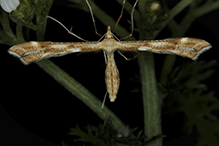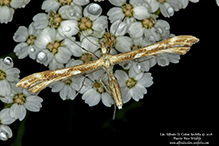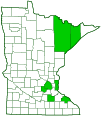Yarrow plume moth
(Gillmeria pallidactyla)
Conservation • Description • Habitat • Ecology • Distribution • Taxonomy
| Hodges # | 6107 |
||
Conservation Status |
|||
| IUCN Red List | not listed |
||
| NatureServe | NNR - Unranked |
||
| Minnesota | not listed |
||
Description |
Yarrow plume moth is common and widespread throughout Europe and across North America. it is found from June to August in a wide variety of dry or damp areas, including gardens and waste places. The body is long, narrow, and pale tan. The upper body is marked with a narrow stripe in the middle (middorsal) and a similar stripe on each side. The stripes may be dark brown, light brown, or barely visible. The wings are held out perpendicular to the body when at rest. The forewings narrow at the base, flared and at least twice as wide at the tip, are deeply notched at the tip. The leading edge (costal margin) of each forewing is straight for three-quarters of its length, then gently convex to the tip. The inner margin is straight and slightly angles backward at the base, then very gently concave to the tip. The basal and median areas have dark brown shading that creates a slanting pale streak between them in the central median area. The costal margin is dark brown, and this widens out into a dark brown triangle at the postmedial line. There is often a small very dark spot at the tip of the triangle. When at rest, the hindwings are folded within the forewing and are not visible from above. The legs are pale brown and very long. The third leg segment (femur) on the front and middle legs is dark brown. The middle leg has a pair of long spurs at the end of the fourth leg segment (tibia). The hind leg has two pairs of spurs on the tibia, one pair in the middle, one pair at the tip. The area between the pairs of spurs is entirely medium brown and has no dark brown rings. |
Size |
Total length: ⅞″ to 1 1 ⁄16″ |
Similar Species |
Habitat and Hosts |
Dry or damp areas, including gardens and waste areas |
Ecology |
Season |
June to August |
Behavior |
During the day adults hide low on foliage. They become active at dusk, are attracted to light, and will come to lights. They rest with their wings spread out at right angles, in a T-shaped profile, like an airplane. |
Life Cycle |
The larvae overwinters in the soil among the roots of the host plant. In the spring it enters young shoots and creates mines as it feeds. In late spring or early summer it pupates on the stem or on a leaf. Adults emerge and are active from June through July. |
Larva Hosts |
Leaves and stems of mostly common yarrow and possibly also common tansy |
Adult Food |
|
Distribution |
||
|
Sources |
|
| 8/26/2025 | ||
Occurrence |
||
Common and widespread |
||
Taxonomy |
|
Order |
|
Superfamily |
Pterophoroidea (Plume Moths and Allies) |
Family |
Pterophoridae (Plume Moths) |
Subfamily |
|
Tribe |
Platyptiliini |
Genus |
Gillmeria |
Subordinate Taxa |
|
|
|
Synonyms |
|
Alucita ochrodactyla Alucita pallidactyla Gillmeria bertrami Gilmeria pallidactyla Platyptilia bertrami var. foculella Platyptilia chapmani Platyptilia pallidactyla Platyptilia pallidiola Platyptilia sachalinensis Platyptilus adustus Platyptilus bertrami Platyptilus bischoffi Pterophorus cervinidactylus Pterophorus marginidactylus Pterophorus migadactylus Pterophorus nebulaedactylus |
|
Common Names |
|
yarrow plume yarrow plume moth |
|
Glossary
Costal margin
The leading edge of the forewing of insects.
Femur
On insects and arachnids, the third, largest, most robust segment of the leg, coming immediately before the tibia. On humans, the thigh bone.
Tibia
The fourth segment of an insect leg, after the femur and before the tarsus (foot). The fifth segment of a spider leg or palp. Plural: tibiae.
Visitor Photos |
Share your photo of this insect. |
||
This button not working for you? |
||
Alfredo Colon |
||
 |
 |
|
MinnesotaSeasons.com Photos |
|

Slideshows |
Gillmeria pallidactyla - Hodges#6107 |
45.008 (1504) Yarrow Plume Gillmeria pallidactyla |

Visitor Videos |
Share your video of this insect. |
||
This button not working for you? |
||
|
Other Videos |
|

Visitor Sightings |
Report a sighting of this insect. |
||
This button not working for you? |
||
| Alfredo Colon 8/31/2018 |
Location: Woodbury, Minnesota |
 |
| Alfredo Colon 6/10/2018 |
Location: Woodbury, Minnesota |
 |
MinnesotaSeasons.com Sightings |
|

|
Created: 11/17/2018 Last Updated: © MinnesotaSeasons.com. All rights reserved. |
